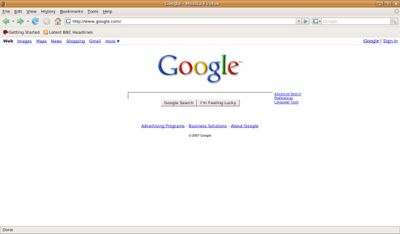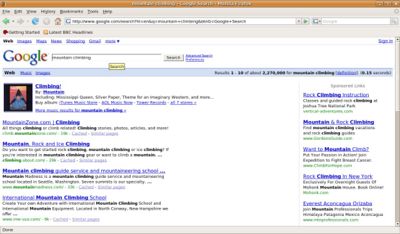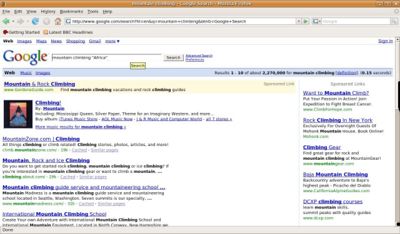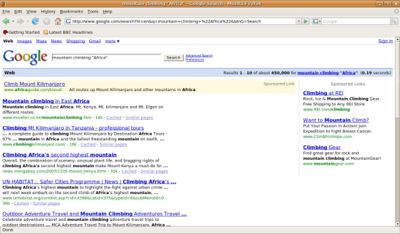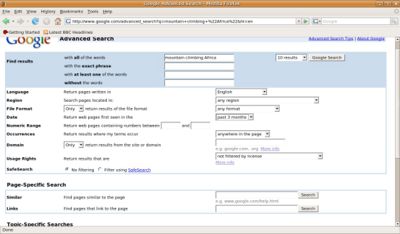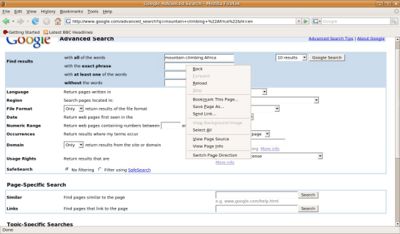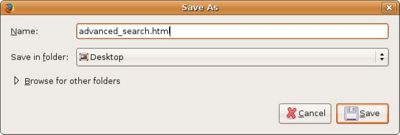CCNC/CCNC Module 7/Web Searching/Using a Search Engine
| Web Searching |
Using a Search Engine | Preparation | Printing | Self Assessment | Summary |
Contents
- 1 Section 1- Using a Search Engine
- 2 Outcomes
- 3 Outcomes
Section 1- Using a Search Engine
Upon completion of this section the learner will be able to:
|
Select a Specific search Engine
It will frequently happen that you want to look up information on the Internet but do not know where to look. In such a case you can make use of a Search engine. A search engine is a web site that will find the locations of web sites for you which contain key words or phrases. There are a number of these available. In the screen showing bookmarks in the section called “Add Web pages to a bookmark folder”, you will see the names and URLs of a number of search engines.
This section will focus on a specific search engine Google. You should, however, familiarise yourself with the other search engines and decide for yourself which you prefer.
- Enter the following URL into the Mozilla Location bar: www.google.com.
- Press Enter or click Search.
The secret of using a search engine such as Google lies in choosing the best key words or phrases to locate useful web sites.
Carry out a Search for Specific Information Using a Keyword, Phrase
Suppose you have a special interest in mountains and you would like to find web sites that can give you information on mountains.
- Type the following phrase “mountain climbing” into the Google Search window including the inverted commas.
- Press Enter or click Google Search.
The search has now been narrowed down to about 378 000 web sites. Clearly the search needs to be narrowed still further.
Each of the web sites is shown as a hyperlink (the underlined blue text).
- Click on a link to view the web site.
- Click the Back icon to return to Google.
- Scroll to the bottom of the Google web page and Click Next to view the next set of links.
Generally, Google attempts to list the most relevant web sites at the top of the list. Combine selection criteria in a search
Suppose your main interest in mountain climbing is in Africa. What you want to look for then are sites which contain both the key phrase “mountain climbing” and the key word Africa.
- Type the following exactly as shown into the Google Search window: “mountain climbing” Africa.
- Press Enter or click Google Search.
At this point, the search has been narrowed down to about 450,000 web sites.
Google Advanced Search
Most search engines have an advanced interface that allows you to be very specific in your search.
- If Google is open, click on the Advanced Search link, or type the following URL into the location bar:
www.google.com/advanced_search?hl=en and press Enter.
The following screen shows how the advanced search can be further restricted to English language sites that have been updated within the past three months.
The Google Advanced Search engine is a very powerful tool. It would be well worth your while to experiment with it an become fully conversant with its use. The Google site also contains tips and a help system.
Duplicate Text, Image, URL from a Web Page to a Document
Text and images can be copied from a web site into a document.
Copy an image into a document
Copying an image from a web site displayed in Mozilla is a two stage process involving saving the image and then inserting it into a document.
- Right click on the image you wish to copy into a document.
- Click Save Images as ...
- Select the directory in which you wish to save the image.
- Give the image a suitable name.
- Click Save.
- Open OpenOffice.org Writer.
- Select the document into which you wish to paste the image.
- Insert->Graphics->From File.
- Locate the image you have saved.
- Click OK.
Copy the Location of the Image into a Document
A web page is often made up of a number of files. In particular, images may be stored as files which are separate to the text. The location of these images can be copied into a document.
- Right click on the image and select Copy Image Location.
- Go to the point in your document where you wish to paste the location.
- Edit->Paste.
Screen Shot needed
Copy the Image From a Web Site to a Document
If your Internet connection is active, you may also be able to copy an image directly as follows:
- Hold down the left mouse button and drag over the image. It should change colour slightly.
- Edit->Copy.
- Go to the point in the document where you wish to paste the image.
Edit->Paste.
Copy Text From a Web Site
Depending on how a web site has been constructed, you may or may not be able to copy the text directly. If the following method does not work, you will first need to save the web page as a text or html file (see next section) and then copy the text from there.
- Go to the start of the text you wish to copy.
- Hold down the left mouse button and drag over the text you wish to copy.
- Edit->Copy
Screen Shot needed
- Go to the point in your document where you wish to paste the text.
- Edit->Paste
Save a Web Page to a Location on a Drive as a Text File, html File =
- Locate the web page you wish to save in Mozilla.
- File->Save As. This will display the Save as dialogue.
- Select the directory in which you wish to save the web page.
Screen Shot needed
- Give the file a suitable name.
- Select the type of file you wish to save it as. The options are described in the following table.
- Click OK.
Word Table, see page 36 of ICOL content document
NOTE image If you save a web page as a text file, you should manually change the file extension to txt to emphasise that you are saving it as a text file. Otherwise Mozilla will retain the existing extension.
The following screen shows part of the above file when saved as a text file. Screen shot of word document
Download Text File, Image File, Sound File, Video File, Software, From a Web Page to a Location on a Drive
Be aware of legal and ethical issues
Although the Internet is a wonderful source of information and software, it unfortunately has a negative aspect as it is possible to acquire illegal software from some sites. There are two things you need to keep in mind when using download sites.
- Downloading illegal software or other electronic material across the Internet amounts to software piracy. This is both illegal and unethical as it infringes on the intellectual property rights of the developer.
- Software from illegal sites may contain viruses.
Download software from the Internet
A very useful site for downloading software legally is Tucows. The following example will illustrate how to download the current implementation of Wine from Tucows. (Wine is a program that allows you to run some Windows programs under Linux without having Windows on your machine.)
- Locate the Linux section of Tucows by typing the following URL into the Mozilla location bar:
linux.tucows.com
Screen shot of website, might need to change website
- Click the Wine link on the screen
This will display some information about Wine. Screen shot
- Click Console under the heading Download on the right hand side of the screen.
- Follow the next couple of screens which require you to select the best mirror site. This is a local site that contains all the Tucows downloads.
- When asked whether you wish to open or save the file, check the Save button.
- Select a directory in which to save the download.
- Either keep the name of the file that is displayed (preferable) or give it a new name.
Screen shot
- Click Save.
If you do change the name of a file, be careful not to change the extension of the file as this could have unforeseen consequences. This is especially the case of files that will be used on Windows systems. On Windows systems the file extension has a special meaning. For example, you can tell executable files in Windows by the fact that they have an exe extension. In Linux, you can only determine whether or not a file is an executable by viewing its properties. An executable file in Linux may not even have an extension. However, even in Linux some extensions such as rpm, tar and zip do have special significance. above BOLD statment needs the NOTE image
Download Text Files
There are a number of sites where you can download books free of charge. One of these is Project Gutenberg. The URL is www.promo.net/pg/ may need to change website example, maybe outdated
In this case we will locate a specific book, 2000 Leagues under the sea by Jules Verne.
- Enter the following URL into the location bar of Mozilla and press Enter:www.gutenberg.net/browse/BIBREC/BR164.HTM
Do we want the URL as a link
- Scroll down towards the bottom of the screen.
Screen Shot
- Click on one of the download option links.
- The next screen will ask you to select a site from which to download the file. Note there are sites in many countries. For quickest download, select the nearest site.
- The process from here on is exactly the same as that described for downloading software.
Download Sound and Video Files updates needed
Most computers have sound cards which enable you to play music and speech. All are stored as sound files of one type or another. There are a range of different formats. One of the most popular is mp3 which compresses the file while still providing good sound quality.
Similarly, movies can be stored as video files.
In order to play sound or video files, you will need to have the appropriate software installed on your computer.
The process of downloading audio and video files is exactly the same as that described for software and text files.
